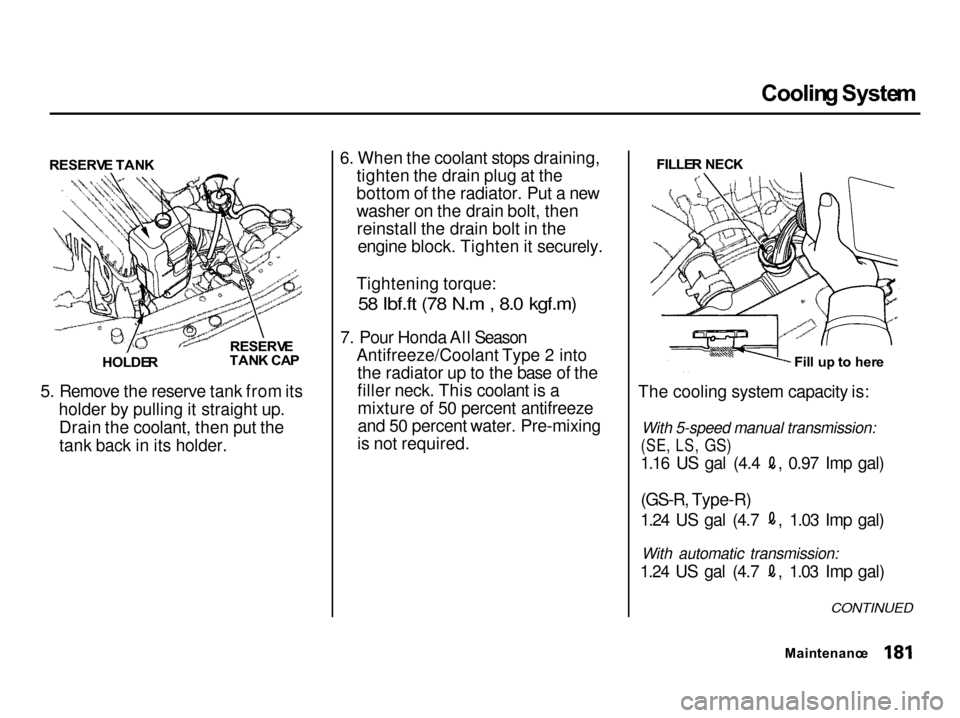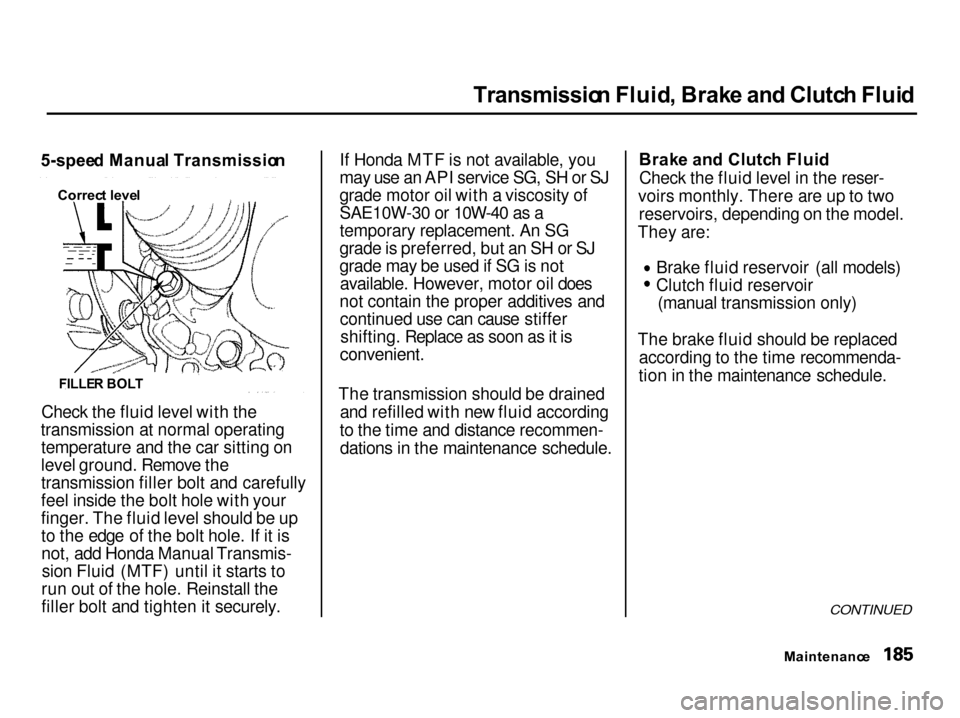Acura Integra 2001 Owner's Manual
Manufacturer: ACURA, Model Year: 2001, Model line: Integra, Model: Acura Integra 2001Pages: 285, PDF Size: 3.79 MB
Page 181 of 285

Coolin
g Syste m
Addin g Engin e Coolan t
RESERV E TAN K
If the coolant level in the reserve
tank is at or below the MIN line, add coolant to bring it up to the MAX line.
Inspect the cooling system for leaks.
This coolant should always be a mixture of 50 percent antifreeze and50 percent water. Never add straight
antifreeze or plain water. Always use Honda All Season
Antifreeze/Coolant Type 2. This coolant is pre-mixed with 50 percent
antifreeze and 50 percent water. Itdoes not require any additional
mixing. If it is not available, you may
use another major-brand non-silicate coolant as a temporary replacement.
Make sure it is a high-quality coolant
recommended for aluminum engines. However, continued use of any non-
Honda coolant can result incorrosion, causing the coolingsystem to malfunction or fail. Have
the cooling system flushed and refilled with Honda antifreeze/
coolant as soon as possible. If the reserve tank is completely
empty, you should also check the
coolant level in the radiator.
Maintenanc e
MI
N MAX Removing the radiator cap
while the engine is hot can cause the coolant to spray out,
seriously scalding you.
Always let the engine and radiator cool down before
removing the radiator cap.
Page 182 of 285

Coolin
g Syste m
1. Make sure the engine and radiator are cool.
2. Turn the radiator cap counter- clockwise, without pressing down
on it, until it stops. This relieves
any pressure remaining in the
cooling system.
3. Remove the radiator cap by pushing down and turning
counterclockwise.
4. The coolant level should be up tothe base of the filler neck. Addcoolant if it is low.
5. Put the radiator cap back on. Tighten it fully. 6. Pour coolant into the reserve tank.
Fill it to halfway between the MAX
and MIN marks. Put the cap backon the reserve tank.
CONTINUED
Maintenanc e
RESERV
E TAN K
RADIATO
R CA P
Page 183 of 285

Coolin
g Syste m
Do not add any rust inhibitors or
other additives to your car's cooling system. They may not be compatible
with the coolant or engine compo-
nents.
Replacin g Engin e Coolan t
The cooling system should be completely drained and refilled with
new coolant according to the timeand distance recommendations in
the maintenance schedule. Only use Honda All Season Antifreeze/Coolant Type 2.
Draining the coolant requires access
to the underside of the car. Unless
you have the tools and knowledge,
you should have this maintenance done by a skilled mechanic. 1. Turn the ignition ON (II). Slide
the heater temperature control
lever to maximum heat. Turn theignition off.
2. Open the hood. Make sure the engine and radiator are cool to the
touch.
3. Remove the radiator cap. 4. Loosen the drain plug on the
bottom of the radiator. The
coolant will drain through thesplash guard. Remove the drain
bolt and washer from the engine
block.
Maintenanc e
DRAI
N PLU G
DRAI
N
BOL T
Page 184 of 285

Coolin
g Syste m
5. Remove the reserve tank from its holder by pulling it straight up.Drain the coolant, then put the
tank back in its holder. 6. When the coolant stops draining,
tighten the drain plug at the
bottom of the radiator. Put a new
washer on the drain bolt, thenreinstall the drain bolt in the engine block. Tighten it securely.
Tightening torque:
58 Ibf.ft (78 N.m , 8.0 kgf.m)
7. Pou
r Honda All Season
Antifreeze/Coolant Type 2 into the radiator up to the base of the
filler neck. This coolant is amixture of 50 percent antifreeze
and 50 percent water. Pre-mixing
is not required. The cooling system capacity is:
With 5-speed manual transmission:
(SE,
LS,
GS)
1.16 US gal (4.4 , 0.97 Imp gal)
(GS-R, Type-R
)
1.24 US gal (4.7 , 1.03 Imp gal)
With automatic transmission:
1.24 US gal (4.7 , 1.03 Imp gal)
Maintenanc
e
CONTINUED
Fil
l u p
t
o her e
RESERV
E
TAN K CA P
HOLDE R
RESERV
E TAN K
FILLE
R NEC K
Page 185 of 285

Coolin
g System , Windshiel d Washer s
8. Start the engine and let it run for about 30 seconds. Then turn off
the engine.
9. Fill the radiator with coolant up to the base of the filler neck.
10. Fill the reserve tank to the MAX mark. Install the reserve tank cap.
11. Install the radiator cap, and tighten it to the first stop.
12. Start the engine and let it run until the radiator cooling fan comes on
at least twice. Then stop the
engine.
13. Remove the radiator cap. Fill the radiator with coolant up to thebase of the filler neck. 14. Start the engine and hold it at
1,500 rpm until the radiator fan
comes on. Turn off the engine.
Check the coolant level in the
radiator and add coolant if needed.
15. Install the radiator cap, and tighten it fully.
16. If necessary, fill the reserve tank to the MAX mark. Install the
reserve tank cap. Windshiel
d Washer s
Check the level in the windshield
washer reservoir at least monthly during normal usage. In bad weather,
when you use the washers often, check the level every time you stop
for fuel. This reservoir supplies the
windshield and rear window washers.
Maintenanc e
Page 186 of 285

Windshiel
d Washers , Transmissio n Flui d
The windshield washer reservoir is located behind the driver's side
headlight. Check the reservoir's fluid
level by removing the cap and
looking at the level gauge attached
to the
cap.
Fill the reservoir with a good-quality
windshield washer fluid. This increases the cleaning capability and
prevents freezing in cold weather. When you refill the reservoir, clean
the edges of the windshield wiper
blades with windshield washer fluidon a clean cloth. This will help to
condition the blade edges.
Do not use engine antifreeze or a vinegar/water solution in the
windshield washer reservoir.
Antifreeze can damage your car's paint, while a vinegar/water solution can
damage the windshield washer pump.
Use only commercially-available
windshield washer fluid.
Automati
c Transmissio n
Check the fluid level with the engine
at normal operating temperature.
1. Park the car on level ground. Shut off the engine.
2. Remove the dipstick (yellow loop) from the transmission and wipe it
with a clean cloth.
CONTINUED
Maintenanc e
DIPSTIC
K
LEVE L GAUG E
WINDSHIEL
D WASHE R RESERVOI R
NOTICE
Page 187 of 285

Transmissio
n Flui d
3. Insert the dipstick all the way into the transmission securely as
shown in the illustration.
4. Remove the dipstick and check the fluid level. It should be
between the upper and lowermarks. 5. If the level is below the lower
mark, add fluid into the filler hole
to bring it to the upper mark.
Always use Honda ATF-Z1 (AutomaticTransmission Fluid). If it
is not available, you may use a
DEXRON ®
III automatic
transmission fluid as a temporary replacement. However, continued
use can affect shift quality. Have the
transmission flushed and refilled
with Honda ATF-Z1 as soon as it is
convenient.
To thoroughly flush the transmission, the technician should drain and refillit with Honda ATF-Z1, then drive the
vehicle a short distance. Do this three times. Then drain and refill the
transmission a final time. 6. Insert the dipstick all the way back
into the transmission securely as
shown in the illustration.
The transmission should be drained and refilled with new fluid according
to the time and distance recommen- dations in the maintenance schedule.
Maintenanc e
UPPE
R MAR K
LOWE R MAR K
Page 188 of 285

Transmissio
n Fluid , Brak e an d Clutc h Flui d
5-spee d Manua l Transmissio n
Check the fluid level with the
transmission at normal operating temperature and the car sitting on
level ground. Remove the
transmission filler bolt and carefully
feel inside the bolt hole with your
finger. The fluid level should be up
to the edge of the bolt hole. If it isnot, add Honda Manual Transmis-sion Fluid (MTF) until it starts to
run out of the hole. Reinstall the
filler bolt and tighten it securely. If Honda MTF is not available, you
may use an API service SG, SH or SJ
grade motor oil with a viscosity of
SAE10W-30 or 10W-40 as a
temporary replacement. An SG
grade is preferred, but an SH or SJ
grade may be used if SG is not
available. However, motor oil does
not contain the proper additives and continued use can cause stiffershifting. Replace as soon as it is
convenient.
The transmission should be drained and refilled with new fluid according
to the time and distance recommen- dations in the maintenance schedule. Brak
e an d Clutc h Flui d
Check the fluid level in the reser-
voirs monthly. There are up to two reservoirs, depending on the model.
They are: Brake fluid reservoir (all models)
Clutch fluid reservoir
(manual transmission only)
The brake fluid should be replaced according to the time recommenda-
tion in the maintenance schedule.
CONTINUED
Maintenanc e
FILLE
R BOL T
Correc
t leve l
Page 189 of 285

Brak
e an d Clutc h Flui d
Always use Honda Heavy Duty Brake Fluid DOT 3. If it is not
available, you should use only DOT 3
or DOT 4 fluid, from a sealed
container, as a temporary
replacement. However, the use of
any non-Honda brake fluid can cause
corrosion and decrease the life of thesystem. Have the brake system
flushed and refilled with Honda Heavy Duty Brake Fluid DOT 3 assoon as possible.
Brake fluid marked DOT 5 is not compatible with your car's brakingsystem and can cause extensive
damage.
Brak
e Syste m
The fluid level should be between the MIN and MAX marks on the sideof the reservoir. If the level is at or
below the MIN mark, your brake system needs attention. Have the
brake system inspected for leaks or
worn brake pads. Clutc
h Syste m
The fluid should be between the MIN and MAX marks on the side of
the reservoir. If it is not, add brake
fluid to bring it up to that level. Use
the same fluid specified for the
brake system.
Low fluid level can indicate a leak in
the clutch system. Have this system
inspected as soon as possible.
Maintenanc e
MA
X
MI N
MI N
MA
X
Page 190 of 285

Powe
r Steerin g
Check the level when the engine is
cold. Look at the side of the
reservoir. The fluid should be
between the UPPER LEVEL and LOWER LEVEL. If it is below the
LOWER LEVEL, add power steering
fluid to the UPPER LEVEL. Always use Honda Power Steering
Fluid. If it is not available, you may
use another power steering fluid as
an emergency replacement.
However, continued use can cause
increased wear and poor steering in
cold weather. Have the powersteering system flushed and refilled
with Honda PSF as soon as possible. A low power steering fluid level can
indicate a leak in the system. Check
the fluid level frequently and have
the system inspected as soon as
possible.
Turning the steering wheel to full left
or right lock and holding it there can
damage the power steering pump.
Maintenance
NOTIC
E
LOWE R LEVE L
UPPE
R LEVE L